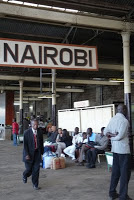In her glorious book, West with the Night, early aviator Beryl Markham talks of spotting from the air for big game hunters and how the elephant herds soon learnt to huddle round and hide the giant tuskers from her plane when they heard the sound of her engine. Tsavo’s elephants were legendary and suffered more than their fair share, first from hunters and later from ivory poachers. Security is now ferocious here and the park is a cornerstone in the preservation of endangered species. At its heart is the Ngulia Rhino Sanctuary, a heavily protected inner sanctum for the black rhino. It is also to Tsavo that the David Sheldrick Wildlife Trust elephant orphanage in Nairobi brings its toddlers at the age of two, to start their reintroduction back to the wild. Yet poachers still prowl around the fringes of the park searching for a way through the heightened security.
The other story – of the Maneaters of Tsavo – belongs to history and the railway. A reign of terror began in 1898 as the railway builders reached the Tsavo river. There had been a long drought followed by a flood, bringing with it disease, during which many of the Indian workers died and were left, according to local African custom in an open cave. There they were found by two exceedingly hungry lions who went from corpses to live Indian ‘coolies’ and over the next eight months created havoc, despite the best efforts of railway boss, American engineer Colonel John Henry Patterson, and a great many hunters who latched on the story and rushed to the area to join the hunt. In all around 135 workers were taken before Col. Patterson eventually managed to shoot the killers, shipping their trophies over to the Chicago Field Museum, where they remain to this day. The Kenyans have asked for them back, enlisting the help of one Senator Barack Obama, and are hopeful that they may one day be displayed in the Railway Museum in Nairobi where they rightfully belong.


Recent Comments